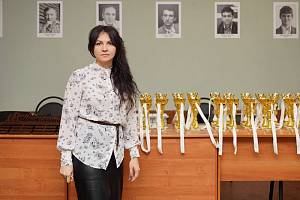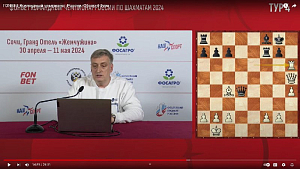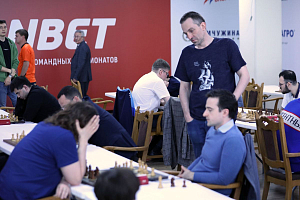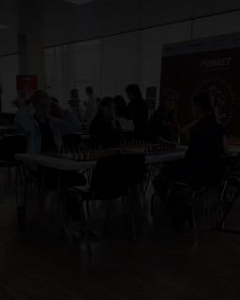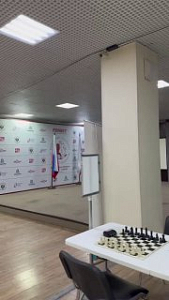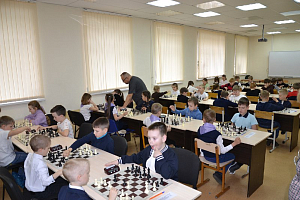7 May 2015
Double Fianchetto, or the Siberian Rocket Hits Hard
2nd round of the Russian Club Championships is thoroughly reviewed by Dmitry Kryakvin.
My arrival at big competitions is always the same. Most of the time I run into Olya Girya, be it at the opening ceremony or in the bus. Actually, there is nothing wrong about it, on the contrary, the grandmaster from Langepas is practically a neighbor of mine for a year and a half . However, the second part of the conversation with our outstanding national team member is usually much less pleasant. Olya looks at me like a strict teacher usually looks at a guilty schoolboy, and says: “Dima, you haven't written about women’s chess again! There is a history of Men's Chess Olympiads, Men's European Chess Cups, but no information about women's competitions. In the last overview you examined the men's event in great detail, but there was not a word about the women... How is that?!” Here I'd like to sink through the floor not to murmur something rubbish about lack of time and that we write about the most interesting occasions for our audience.
By the way, today I had a nightmare about women’s chess. Participants of the women’s competition were annoyed that such a great event like Russian Club Championship in Grand Hotel Zhemchuzhina had no press coverage. In the background Nigel Short was roaring like the devil, messing around with poor women. Then came Garry Kimovich Kasparov and defeated him 8,5-1,5, after which Nigel whistled and dissolved into thin air. And there I heard a cock, and, having blessed myself like Khoma Brutus, first and foremost started writing about the women’s event.
Ladies
The women's event counts 10 teams, and they fight for 3 tickets to the European Chess Club Cup, which will be held in charming Macedonia, in one of the most chess cities of the previous Yugoslavia – Skopje. There are two main favorites: the powerful Moscow team – Kosteniuk, Gunina, Girya, Kovalevskaya and Kashlinskaya, and the armada of Pavel Lobach from the glorious Khanty-Mansyisk – Ushenina, Pogonina, Mkrtchian, Guseva and Kovanova. Average ratings of the next three teams are little below: SDYUSSHOR from St. Petersburg traditionally fights only by it's own forces, and now they came without reserve players, girls from Belorechensk invited Dasha Pustovoitova and Guliskhan Nakhbaeva, but the most interesting story provides Boavista from Moscow. One day Russian Girls U21 champion Alina Bivol decided that she wants to play in the Russian Club Championship on the first board, and assisted by the leader of men’s Boavista, Mikhail Demidov, started assembling a team. She succeeded, and Boavista came to Sochi.
In the second round fierce battles began, and “folk” teams put up a hard resistance against women’s top clubs.
Pustovoitova (University) – Ushenina (Ugra)

The match with Belorechensk was quite distressing for Ugra. Nakhbaeva had a positional bind against Mkrtchian, Kovanova came through a bad position and defeated Marina Baraeva, having shown outstanding tactical skills. Strengths were balanced, taking into account an equal position in Bronnikova-Guseva, much depended on the first board.
38...Rc2
Of course, under the time pressure 99% of chess players would make such move, and only the computer shows 38...Qe3!? 39.Qh4! (39.Re1 Rc1 40.Qh4 Be7 41.Qg3 f4 and 39.Qg6 Rc1+ 40.Rxc1 Qxc1+ 41.Ng1 Bc5 defeats, and 39.Rf1 Rc5 40.Qh4 Bc7 leaves White without an important pawn а5) 39...Rc1+ 40.Rxc1 Qxc1+ 41.Qe1 Qxe1+ 42.Nxe1 Bb4 43.Nd3 Bxa5. Black took a distant passed pawn, besides she has two bishops, but the clear 44.Ne5 Be8 45.Bc8! should deprive her of any advantage. It seems the position is drawish.
39.Qg6 Bg3 40.Bf1 Rc3
How can White defend? The f3-square falls apart, and the indirect defense 41.Qa6 Kh7 42.Qe2 doesn't work: 42…Qc5 43.a6 Bc6, and Black should reach the white king. However, White can still survive nicely, and Dasha Pustovoitova succeeds in finding it.
41.Qf7! Qc2
This is forced, because even 41...Rxf3 loses to 42.Bc4! Kh7 43.Qg8+ Kg6 44.Bf7+! Kf6 45.Qd8+ Kxf7 46.Qxd7+ Kg8 (46...Kg6 47.Qc6+) 47.Qd5+, and the rook f3 is lost.
42.Qxd7 Qxb1
The exchange is gained, but White forces the perpetual check.
43.Qe8+ Kh7 44.Ng5+! hxg5 45.Qh5+ Kg8 46.Qe8+ Kh7 47.Qh5+, and the match ended 2-2. A very strongly played endgame, and the impression does not dissolve even after performing the computer analysis!
In other principled match the Petersburgers, assembling an optimal team composition with Bodnaruk and Ovod (I wish Katya Korbut was here as well), managed to overcome the fearsome Muscovites. A gladiator battle on the first board set the pace to the match.
Kosteniuk (SHSM) – Bodnaruk (SDYUSSHOR SHSH)
1.e4 c5 2.Nf3 d6 3.d4 cxd4 4.Nxd4 Nf6 5.Nc3 a6 6.Bg5 Nbd7
It was widely thought that Anastasia Bodnaruk is one of the most talented Russian chess players, but at the same time her soft spot is opening. Recently her opponents in the Russian Championship Superfinal, who enjoyed more powerful analytical support, used it to their benefit. Well, the following game defies the longstanding stereotype. Bodnaruk defeats the former World Champion, playing the Najdorf as Black, and makes it look as easy as if her name was not Anastasia, but, say, Maxime Vachier-Lagrave.
This is a popular opening line usually chosen by Najdorf enthusiasts who do not want to deepen in 40-moves jungles of the Poisoned Pawn Variation 6…e6 7.f4 Qb6 or 7…h6 8.Bh4 Qb6.
7.Qe2
In the Soviet times it was thought that the only move here is 7.Bc4. In the book about Boris Spassky it is written that other moves, which have nothing in common with the idea of attacking the e6-square, do not create any problems for Black. However, the modest queen move with the idea of breaking in the center became much more popular these days.
7...h6 8.Bh4 g6 9.f4
The best Chinese players prefer dealing with this variation differently: 9.0–0–0 e5 10.Nb3 Be7 11.f3 b5 12.Qd2 with the most complicated Sicilian game. However, women prefer pushing the f-pawn. Kosintseva sisters, Hou Yifan and Alexandra herself played so. Black's position was mainly defended by Anna Ushenina, armed with groundworks of Anton Korobov.
9...e5 10.fxe5 dxe5 11.0–0–0 Qc7
It is clear that 11...exd4 12.e5 loses, and now we have the most important choice.

12.Nd5
Tatiana Kosintseva, Igor Kurnosov and other grandmasters preferred 12.Nb3 b5 13.Qf3 (or 13.Nd5 Nxd5 14.exd5 Bd6 15.Qd2 Kf8, T.Kosintseva-Ushenina, 2013) 13...Bg7 14.Bd3 0–0 15.g4 Bb7 16.a3 Bc6 Т.Kosintseva-Ziaziulkina, 2013, but in the recent Ukrainian Championship Superfinal Stas Bogdanovich, playing White, used a new plan that confused the classic of the variation.
12...Nxd5 13.exd5 Bd6 14.g4?
Bogdanovich-Korobov, 2014 went on 14.Nb3 b5 15.Nd2 Nc5 16.Kb1 f5 17.g4 0–0 18.Bh3, and White eventually carried out a wonderful mating attack. Sadly, the former Women's World Chess Champion effort to modernize White's attack construction runs into a rough reply.
14...h5! 15.gxh5
15.g5 is unacceptable, as 15.h3 hxg4 16.hxg4 g5 loses a piece, thus White is obliged to deal with the active rook and sound the retreat.
15...Rxh5 16.Nf3 Nc5 17.Rg1 Bf5 18.Bf2 Rc8

All Black's pieces are active, and the clouds gather over Kosteniuk's king.
19.Bxc5
19.Kb1 Na4 20.Nd4 Qb6 loses, that's why the dangerous knight must be exchanged.
19...Qxc5 20.c4
20.c3 Qa5 loses on the spot.
20...Kf8 21.Rg5 Rxg5 22.Nxg5 b5 23.Ne4 Bxe4 24.Qxe4 bxc4
White reduced the attacking potential of her opponent and got opposite-colored bishops in the endgame. Unfortunately, being a pawn down, having a bad pawn structure and an insecure king, she has no chances to survive.
25.Kb1 c3 26.Rc1 Qb6 27.b3
A little more persistent is 27.Rc2 a5 28.Qd3, and now Bodnaruk wins with no trouble.
27...f5 28.Qh4 Kg7 29.Bd3 e4 30.Bc2 Qc5 31.Ka1 Rh8 32.Qe1 Rxh2 33.b4 Qd4 34.a3 a5 35.bxa5 Qc5 White resigns.
Belenkaya drew with Kovalevskaya, a hard fight accompanied the game of two Alinas: Kashlinskaya and Balaian, while at the same time... Generally speaking, a bad commentator is he who doesn't write about Valya Gunina!
Ovod (SDYUSSHOR SHSH) – Gunina (SHSM)

The battle is in full play, and the simple 28...Kxg7 29.Ng5 Qg6 is called for. However, it is all too trivial for Gunina. Looking through her games, one cannot help coming to the conclusion that she used to work with prince Kutuzov. In worse positions Gunina has only one strategy – to inveigle the opponent on her territory, maul her, let her occupy the capital, and then crush decisively and push as far away as possible.
28... Qg6?!?!?
Probably the coaches of both teams were astonished here. It's a good thing that Sergei Rublevsky was playing his own game at that moment!
29.Qh8+ Kf7 30.Be3?
30.Be2! Ke7 31.Bh5 wins straight away, and after 30...Qxg7 31.Qh5+ Kg8 32.Qxf5 Nbd5 33.Bxd5 Rxd5 34.Nf6+ Kf8 35.Nh7+ Ke7 the attack of Evgenia Ovod lost its force, and Valya eventually won.
And yet the capricious Fortuna punished the Moscow team on the 4th board. Kashlinskaya, fighting for a victory, went too far, and Balaian showed perfect endgame technique, securing a 2.5-1.5 win for SDYUSSHOR.
The Boavista army also won two matches, now they will have an important match with St. Petersburg.
Gentlemen
After being already glorified in myths and legends, the battle between Siberia and Malachite, the details of which you have probably read in the excellent review of my colleague Sergei Shipov, Siberians were to have another butting game – with St. Pete, famous for its team spirit. Not long ago Vladimir Bykov made an important rearrangements in the team, the most important of them being the appearance of such a promising player as Volodia Fedoseev. A great battle was expected, taking into account that the leader of Siberia Vladimir Kramnik demanded an immediate revenge for his defeat against Shirov.
By the way, visiting the Chess Bomb I bumped into the following appeal in comments to one of the games: “Long live Siberia! Let's beat SOCAR at the European Club Cup with a help of Carlsen, comrades!” Who knows, who can join the powerful Premier League newcomer at the European Club Cup? Yet it seems Kramnik and Aronian are doing well even without Magnus.
Kramnik (Siberia) – Svidler (Bronze Hourseman)
Favorite double fianchetto of Vladimir Borisovich
1.Nf3 Nf6 2.g3 d5 3.Bg2 g6 4.b3 Bg7 5.Bb2 c5 6.c4
It is no longer a secret that Kramnik can play it. And everyone knows that Kramnik's prep in his sidelines is just as serious as he is about the Berlin Defense.
6…d4
The recent Bukavshin-Eliseev continued 6…0-0 7.схd5 Nхd5 8.Bхg7 Kхg7 9.0-0 Nc6 10.Qc1, and in the further battle Vanya has decisively proved that this plan is not so harmless for Black, winning the most important game in the Russian U21 Championship. Peter Svidler prefers to occupy space in the center.
7.b4
Vladimir Malakhov preferred the reserved 7.e3, and the b2-pawn push is known for not less than 50 years. It is not even a Benko Gambit with colors reversed, as the d4-pawn is loose.
7...Nfd7!
A competent reaction, which was used by Mikhail Tal. Black knight without comes to c5 without wasting any time.
8.0–0 Nc6 9.bxc5 0–0 10.d3 Nxc5 11.Nbd2

The key position, which was often seen in Anthony Miles' games. Here Tal put forward a bishop – 11...Bg4, and Andrey Sokolov in his prime chose a careful 11...a5. In those games Black scored half a point out of two. Svidler with his unique memory goes down the main road again.
12…Rb8 12.Ba3 Qa5
The main point of Black's idea – if he chases the bishop away, he will solve all the opening problems. Therefore, White's reply is forced.
13.Qc1 Na4
Curiously, this position occurred once in advanced chess. The strictly preventive 14.Re1 led to a complicated game that eventually ended in a draw. Vladimir Kramnik makes a more concrete and natural move, which confronts Svidler with a choice.
14.Nb3
Where should the queen go? I suppose, that if Svidler, like in “Butterfly effect”, could return to the position after the 14th White's move, he would have chosen 14...Qh5. Now 15.Qc2 Bg4 16.Rae1 Nc3 17.Bc5 Rfd8 18.Bxd4 Nxe2+ 19.Rxe2 Bxf3 20.Bxf3 Qxf3 brings White nothing, the endgame after 15.Qg5 Qxg5 16.Nxg5 Nc3 17.Rfe1 looks quite equal, and 15.e3!? dxe3 16.Qxe3 has the only problem – Black is not obliged to take an exchange.
14...Qc7 15.Qc2 Bd7 16.Rae1 Rfd8?!
Black does not see direct dangers so far and even provokes White to bring his center in motion to start undermining it in the Grünfeld manner. Knowing the outcome, perhaps it was worthy to start the struggle on the queenside, where Black has an advantage: 16...b6 17.e3 dxe3 18.fxe3 a5, preparing a knight's jump on b4.
17.e3 dxe3 18.fxe3

18…h6?!
Daring to play the inhuman 18...Bc3! 19.Rd1 Nb4 20.Qf2 f6! 21.Nfd4 is very hard, if you are not Stockfish or Houdini. Black's pieces are loose, however the computer doesn't see any clear danger.
19.d4 Bf5?
Last step into the abyss, but it is hard for a human to foresee the fantastic resource White has on the 22nd move.
20.e4 Bg4
Now after 21.Qf2 Bxf3 22.Qxf3 e6 White's center is vulnerable and needs protection. However, Kramnik calculates a great combination.
21. e5! Nb6
The knight should be retreated, because after 21...Bxf3 22.Rxf3 Nxd4 the a4-knight is threatened.

What comes next? The d4-pawn is attacked, and after 22.Qc3 Rbc8 Black brings the last piece into action, and the triumph of hypermodernism is close, because the nice-looking center is about to fall apart. And here comes a thunderbolt!
22.Nh4!!
Simply incredible! The unexpected knight leap creates amazing harmony for Kramnik's pieces.
22...Nxd4 23.Qf2! Qxc4
The line of the least resistance, but in other lines White also wins nicely: 23...Be6 24.Nxd4 Bxc4 25.Nb5! Qd7 (also there is no escape after 25...Bxb5 26.Qxf7+ Kh8 27.Nxg6+ Kh7 28.Nf8+ Kh8 29.Ne6) 26.e6! Bxe6 27.Bh3! – it is sad that this line did not happen during the game. The prosaic 23...Nf5 24.e6 Rf8 (or 24...fxe6 25.Rxe6 Qxc4 26.Re4) 25.exf7+ Rxf7 26.Nxg6 gives White a decisive attack.
24.Re4 Be6 25.Nxd4 Bd5
The last Black's cartridge turned out to be blank.
26.Ne6! Bxe6 27.Rxc4 Nxc4 28.Bxe7 Rd2 29.Qxa7 Bxe5 30.Nf3 Bc7, and Black resigned without waiting for the response. Of course, the queen easily overcomes the rook.
However, the match battle still was not over. In the second half Bykov's youngsters started pushing, and it seemed that Anton Korobov was on the edge of defeat against Ildar Khairullin. The computer was shiwing the disappointing +2 in favor of Ildar, and Pasha Maletin, with whom I chatted on Facebook, sent me a sad smiley.
Korobov (Siberia) - Khairullin (Bronze Hourseman)

White is down two pawns, and only hopes for his passed pawn.
32.c6! Rc7?!
Of course, 32...b5! could make it into books of Mark Dvoretsky and Vladimir Grabinsky, titled “Remember about the opponent. For child prodigies”. After 33.cxd7 (or 33.Qxb5 Rxd4 34.c7 Nd7! 35.c8Q Rxd1+ 36.Rxd1 Rxc8 37.Qxd7 Rc2 38.Qxa7 g6) 33...bxa4 34.dxe8Q+ Nxe8 35.Rc8 Qe7 36.Nc6 Qc5+ 37.Kh2 Kh7 Black retains very good chances. But what is wrong with blocking the pawn with a rook?
33.Rc4! Rd8
33...a6!? 34.Qxa6 Qf4 would continue the game with all three results possible. After the text-move White is pinned and is still two pawns down, but Anton has already calculated everything to the end.
34.Nxe6! Rxd1+ 35.Qxd1 Qxc4 36.Qd8+ Kh7 37.Nf8+ Kh6 38.Qxc7 Qc5+ 39.Kh1 Qxf8

It seems the complications are over and Black wins after little more gunfire – 40.Qb7 Nd5 41.c7 Ne7, converting an extra piece. However, Korobov has calculated two moves further.
40.Qf4+ Kg6
The 40...Kh7 retreat helps a passed pawn 41.Qf5+. Now a plain little pawn weights the scales on behalf of Siberia.
41.g4!! hxg4 42.fxg4
In light of White's threats the draw becomes unavoidable.
42…Qd8 43.Qf5+ Kh6 44.g5+ Kh5 45.gxf6+ g5 46.Qd7 Qxf6 47.c7 with a draw by perpetual.
After two matches Siberians scored 4 match points. Only University is on par with them, who defeated Kazan in a match.
Rublevsky (University) - Yandemirov (Kazan)

Valery Petrovich Yandemirov for a long time crafty bound an attack of the head coach of the women's National team, and after 44...Nd5 the outcome of the battle remained unclear. However, the active-looking 44... Qb2? ran into 45.Qc3!, trading the queens. 45...Qxc3 46.Nxc3 Kg7 47.Re2, and it turned out that Black can not hold the blockade of passed pawns. 47...h6 loses to 48.Rf2! Rf8 49.Rd2, and 47...Rd4 is no better – 48.Ne4 Nd5 49.Nxg5 Nf6 50.Nf3 Rd3 51.g5 wins.
University also won on the last board – 4-2.
Malachite won its match against Lada with the same score. Khismatllin had a bright attack, but made a blunder under the time pressure against Brodsky. Bukavshin pushed Malakhov, but finally the only goal of Lada was answered by three goals of Malachite.
The match between Moscow and Yamal nearly produced an upset. The severe children of the North and the Polar night fought to the bitter end, and although Ivan Popov beat Savitsky, Grachev had a tough ending against Sergeyev, and none of the Yamal players was any worse on the other boards. The SHSM leader was forced to undertake dynamic actions to secure the match win.
Nepomniachtchi (SHSM) - Potapov (Yamal)

The pawn on g2 can not be borne any longer, and Ian sacrifices an exchange, putting an end to the mating threat of the opponent.
39.Rxc6! bxc6 40.Qg5 Rh7
The fearless 40...Kg7 with the idea of running away with the king after 41.Nxh5+ Kf7 is strongly met by 41.Rf3!
41.Rf3?!
The battle could finish quicker after 41.e6! Qb1+ (41...Qf5 42.e7; the following sequence is quite nice: 41...Kg7 42.e7 Rxf6 43.e8N+!) 42.Kxg2 Qf5 43.Qxf5 gxf5 44.Nxh7 Kxh7 45.e7 Re8 46.Re6 Kg7 47.Rxc6 Rxe7 48.Rxc5 Rb7 49.Rb5 with a winning rook endgame. Nepomniachtchi decided to finish the battle with queens on the board, but Potapov has found a resource, which allowed Black to create strong defense on the final frontier.
41...h4 42.Kxg2 Qe2!
The rook is surrounded, so the Muscovite has to rearrange his forces.
43.Rf4 h3+ 44.Kh2 Qd2 45.Qg3 Kg7 46.Rf3 Rhh8 47.Rd3 Qe2 48.Rd6 Qc2?
White made decent progress and enjoys a clear advantage, but after the cool 48...Rf7 I cannot see how the weakness of g6 can be utilized immediately, so Black retains some chances of survival. Now Nepomniachtchi ends the battle forcefully.
49.Rxc6 Rc8 50.Re6 Rc7
More persistent is 50...Rcf8.

51.Re8! Rc8 52.Re7+ Kf8 53.Ra7 Qf5 54.Nd5 Re8, and Black resigned after an elegant 55.e6 Qxe6 56.Qf4+ in view of 56…Qf5 57.Qd6+ Kg8 58.Nf6+.
The Moscow team avoided losing an important point and still has chances to fight for medals. However, the main struggle is ahead.













